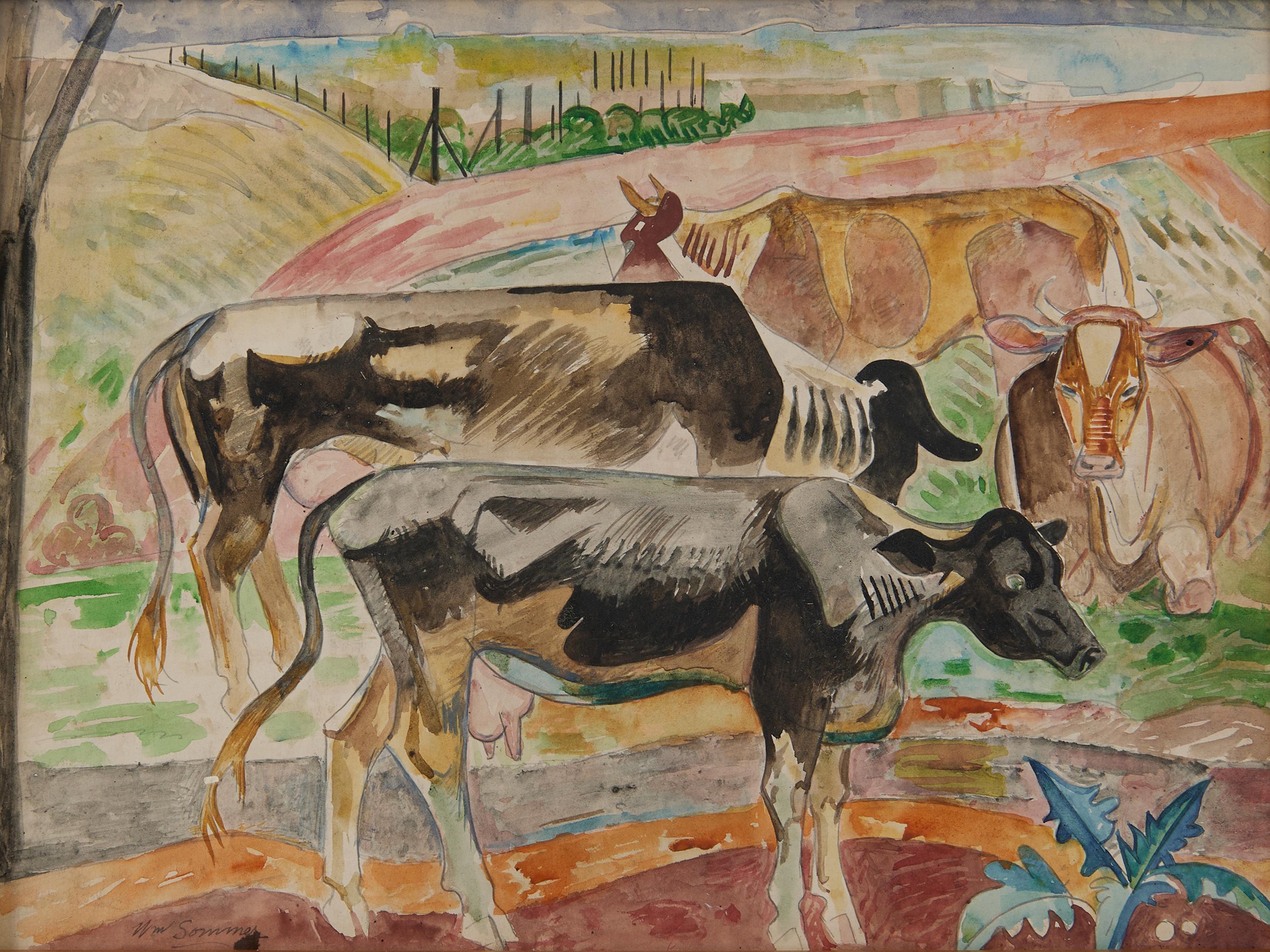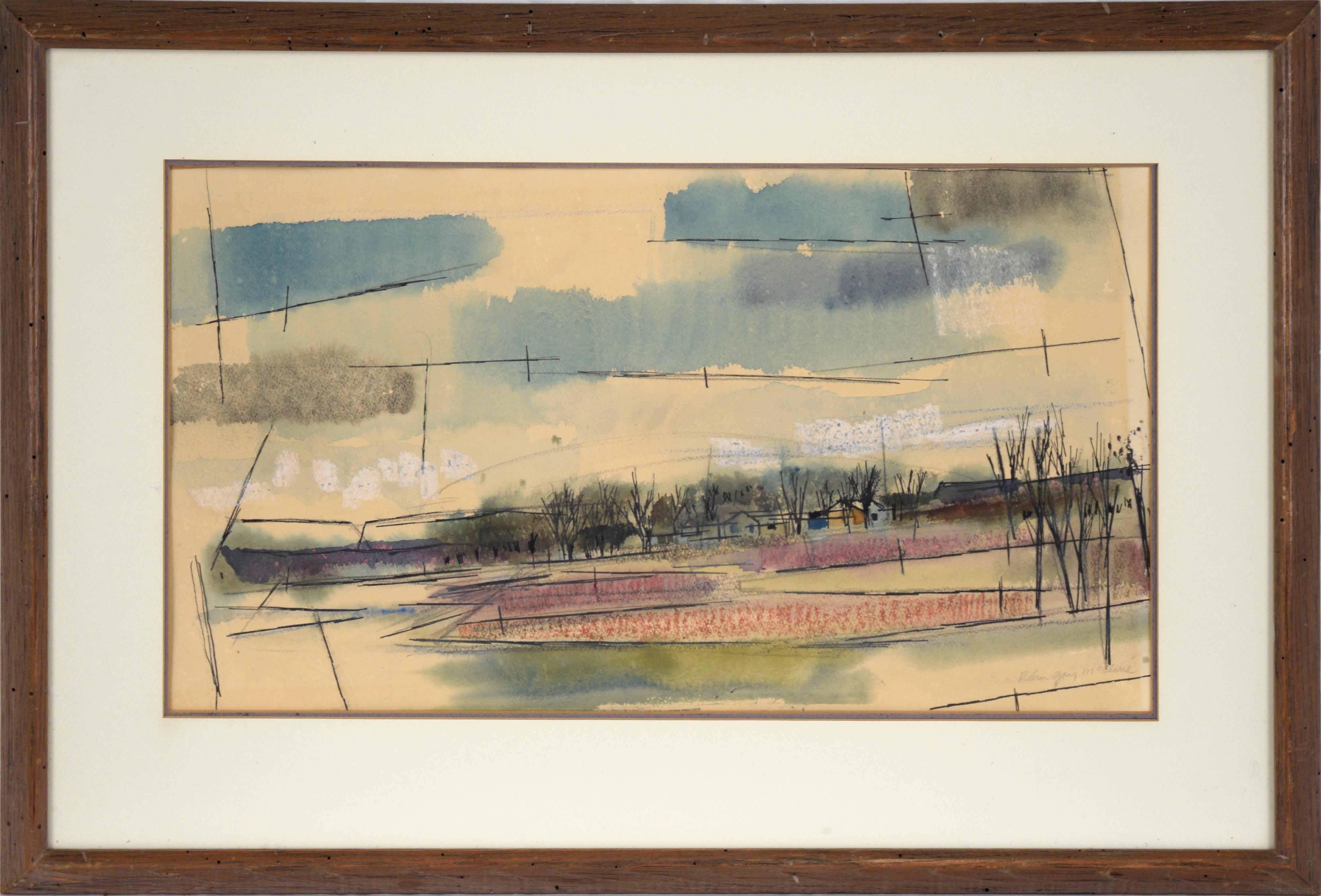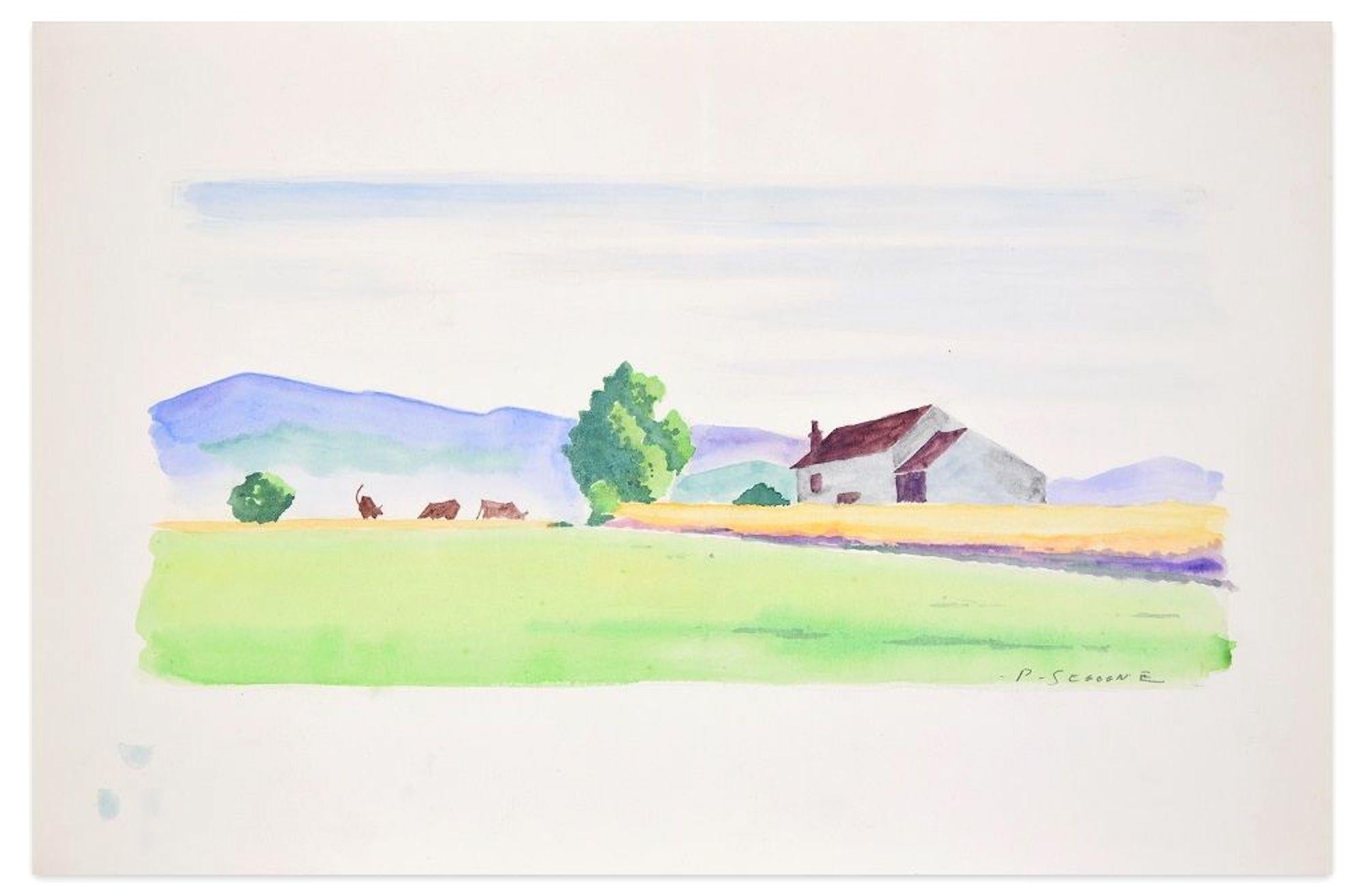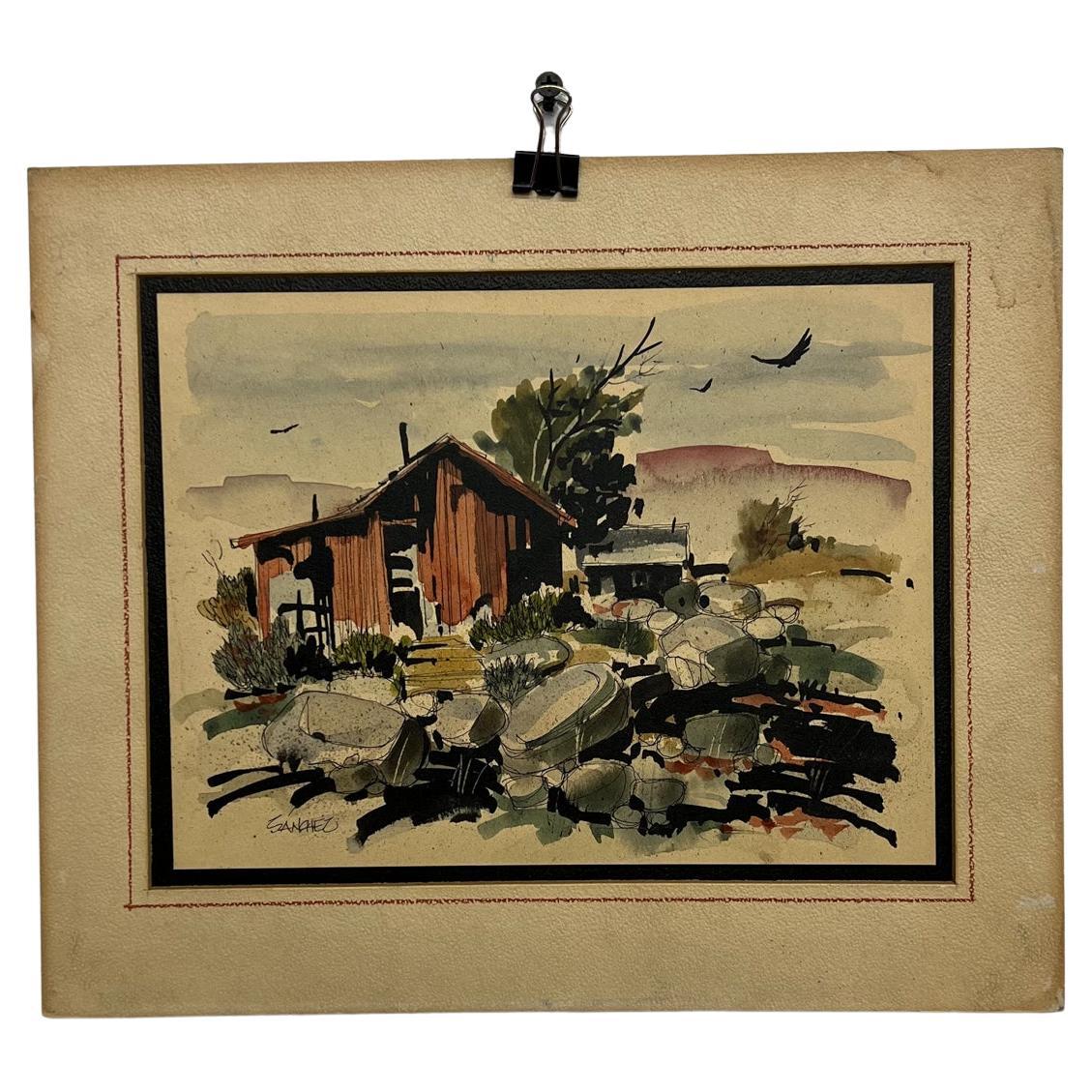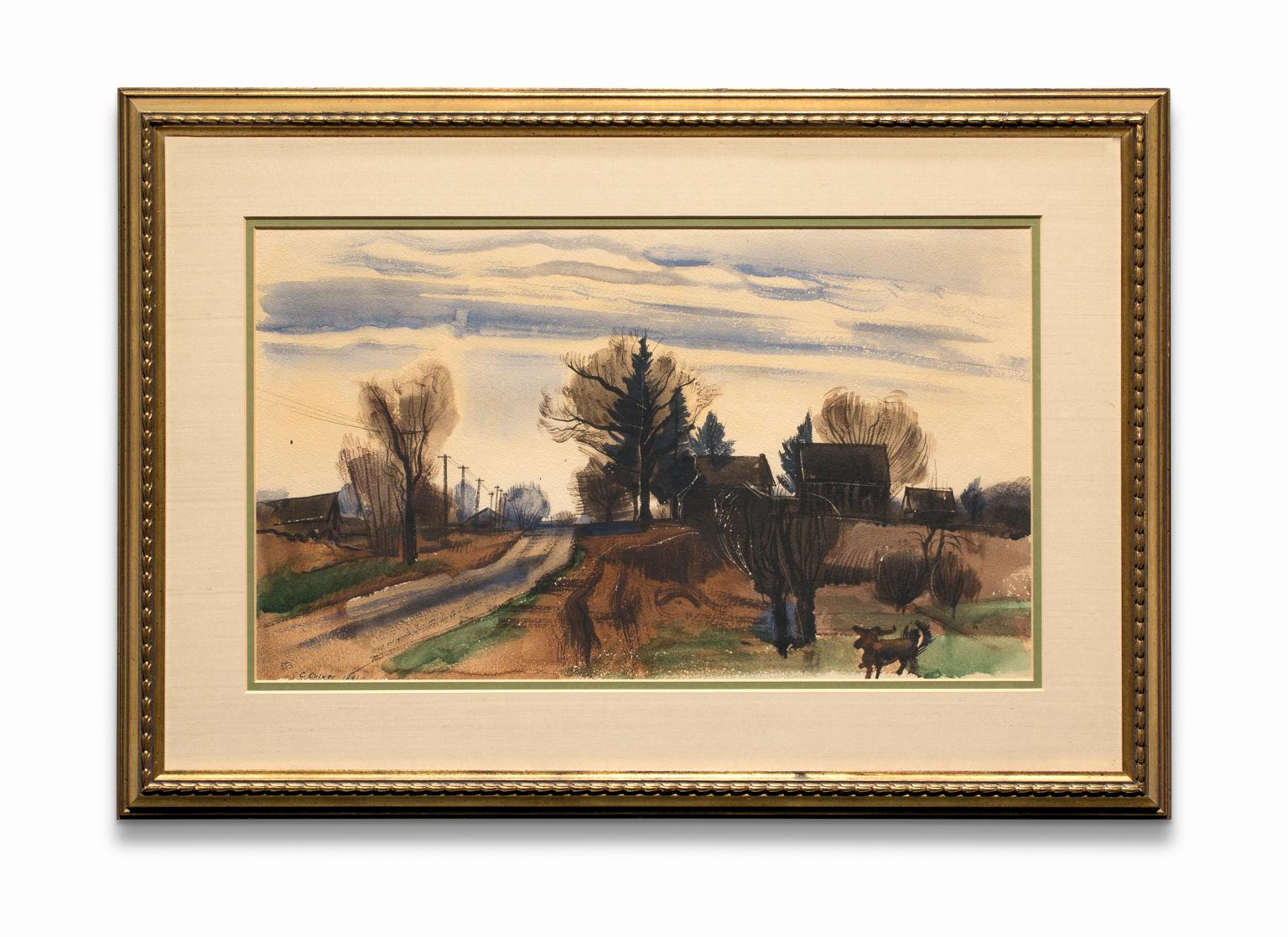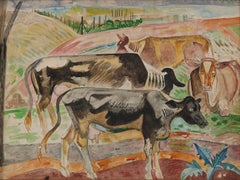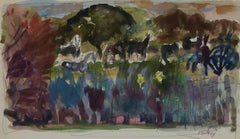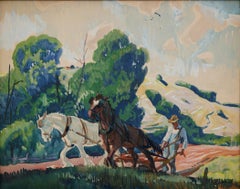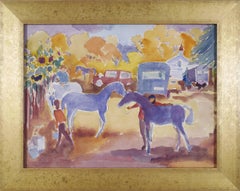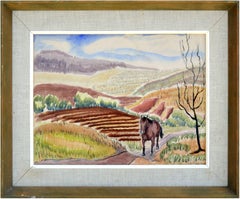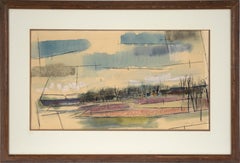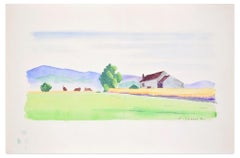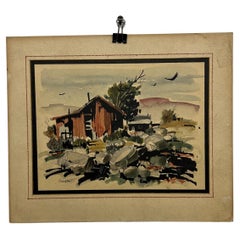Items Similar to Mid Century Modernist Watercolor Landscape with Horse, Cleveland School
Video Loading
Want more images or videos?
Request additional images or videos from the seller
1 of 16
William SommerMid Century Modernist Watercolor Landscape with Horse, Cleveland School
$8,500
£6,489.71
€7,498.80
CA$11,932.39
A$13,299.89
CHF 6,978
MX$162,413.38
NOK 88,356.62
SEK 83,510.45
DKK 55,966.84
About the Item
William Sommer (American, 1867–1949)
Spring Beauty
Watercolor on paper
Signed lower right
12.5 x 17 inches
18 x 22.75 inches, framed
William Sommer is seen as a key person in bringing European modernism to Northeast Ohio. He was born in Detroit, Michigan, and in his youth apprenticed for seven years to a lithographer.
He briefly studied at an art academy in Germany and then worked as a lithographer in New York before moving to Cleveland, where he was awarded a major contract with the Otis Lithography Company. There he became friends with sculptor and painter William Zorach, and the two, determined to be fine artists, began painting together on weekends. They also became intrigued by avant-garde movements, especially after Zorach's trip to Paris in 1910.
In 1911, Sommer co-founded a group in Cleveland called the Kokoon Club, a mixed group of commercial artists and radical modernists who sought the freedom to pursue their independent tendencies. They converted a tailor's shop into a studio and held exhibitions and lectures and organized an annual masked ball that became the focus of Cleveland's bohemian life.
In 1913, he and his colleagues began painting at Brandywine, about 30 miles south of Cleveland and made a school house into a studio. They devoted increasing time to watercolor painting because they could work spontaneously and it would dry quickly. Rejecting the conventional ideas of beauty, they strove for the expression of emotion and spontaneity and fantasy. One of Sommer's most successful students was Charles Burchfield.
As he was perfecting his mature style, he had financial difficulties because he made his living from commercial lithography, which was becoming obsolete, and the Depression was hitting the nation causing him to lose his job. He became a WPA artist, doing murals in northeastern Ohio.
After his death at age 82, he was largely forgotten until 1980 when Hilton Kramer, a "New York Times" critic, praised his work. In May to July, 1994, the Ohio Arts Council held a retrospective of his work at the Riffe Gallery in Columbus. His work is found in many public collections including the National Museum of American Art, The Metropolitan Museum of Art, and the Whitney Museum of American Art.
- Creator:William Sommer (1867-1949, American)
- Dimensions:Height: 18 in (45.72 cm)Width: 23 in (58.42 cm)
- Medium:
- Movement & Style:
- Period:
- Condition:
- Gallery Location:Beachwood, OH
- Reference Number:1stDibs: LU1768210716202
William Sommer
William Sommer is seen as a key person in bringing European modernism to Northeast Ohio. He was born in Detroit, Michigan, and in his youth apprenticed for seven years to a lithographer. He briefly studied at an art academy in Germany and then worked as a lithographer in New York before moving to Cleveland, where he was awarded a major contract with the Otis Lithography Company. There he became friends with sculptor and painter William Zorach, and the two, determined to be fine artists, began painting together on weekends. They also became intrigued by avant-garde movements, especially after Zorach's trip to Paris in 1910. In 1911, Sommer co-founded a group in Cleveland called the Kokoon Club, a mixed group of commercial artists and radical modernists who sought the freedom to pursue their independent tendencies. They converted a tailor's shop into a studio and held exhibitions and lectures and organized an annual masked ball that became the focus of Cleveland's bohemian life. In 1913, he and his colleagues began painting at Brandywine, about 30 miles south of Cleveland and made a school house into a studio. They devoted increasing time to watercolor painting because they could work spontaneously and it would dry quickly. Rejecting the conventional ideas of beauty, they strove for the expression of emotion and spontaneity and fantasy. One of Sommer's most successful students was Charles Burchfield. As he was perfecting his mature style, he had financial difficulties because he made his living from commercial lithography, which was becoming obsolete, and the Depression was hitting the nation causing him to lose his job. He became a WPA artist, doing murals in northeastern Ohio. After his death at age 82, he was largely forgotten until 1980 when Hilton Kramer, a "New York Times" critic, praised his work. In May to July, 1994, the Ohio Arts Council held a retrospective of his work at the Riffe Gallery in Columbus. His work is found in many public collections including the National Museum of American Art, The Metropolitan Museum of Art, and the Whitney Museum of American Art.
About the Seller
5.0
Vetted Professional Seller
Every seller passes strict standards for authenticity and reliability
Established in 1975
1stDibs seller since 2022
34 sales on 1stDibs
Typical response time: 1 hour
- ShippingRetrieving quote...Shipping from: Beachwood, OH
- Return Policy
Authenticity Guarantee
In the unlikely event there’s an issue with an item’s authenticity, contact us within 1 year for a full refund. DetailsMoney-Back Guarantee
If your item is not as described, is damaged in transit, or does not arrive, contact us within 7 days for a full refund. Details24-Hour Cancellation
You have a 24-hour grace period in which to reconsider your purchase, with no questions asked.Vetted Professional Sellers
Our world-class sellers must adhere to strict standards for service and quality, maintaining the integrity of our listings.Price-Match Guarantee
If you find that a seller listed the same item for a lower price elsewhere, we’ll match it.Trusted Global Delivery
Our best-in-class carrier network provides specialized shipping options worldwide, including custom delivery.More From This Seller
View AllCows in a Field, Early 20th Century American Modernist Landscape Watercolor
By William Sommer
Located in Beachwood, OH
William Sommer (American, 1867-1949)
Cows in a Field
Watercolor on paper
Signed lower left
11.5 x 15.5 inches
17.5 x 21.5 inches, framed
William Sommer is seen as a key person in br...
Category
Early 20th Century American Modern Animal Drawings and Watercolors
Materials
Watercolor
Horses in Landscape, Late 20th Century Watercolor by Cleveland School artist
By Joseph O'Sickey
Located in Beachwood, OH
Work sold to benefit the CLEVELAND INSTITUTE OF ART
Joseph B. O’Sickey (American, 1918–2013)
Horses in Landscape
Watercolor and graphite on paper
Signed lowe...
Category
Late 20th Century Post-Impressionist Landscape Drawings and Watercolors
Materials
Graphite, Watercolor
Plowman, Brecksville, Ohio, Early 20th Century Farm Landscape, Cleveland School
By Frank Wilcox
Located in Beachwood, OH
Frank Nelson Wilcox (American, 1887–1964)
Plowman, Brecksville, Ohio, c. 1922
Watercolor on paper
Signed lower right
22.5 x 27.75 inches
27.75 x 34.5 inches, framed
Frank Nelson Wilcox (October 3, 1887 – April 17, 1964) was a modernist American artist and a master of watercolor. Wilcox is described as the "Dean of Cleveland School painters," though some sources give this appellation to Henry Keller or Frederick Gottwald. Wilcox was born on October 3, 1887 to Frank Nelson Wilcox, Sr. and Jessie Fremont Snow Wilcox at 61 Linwood Street in Cleveland, Ohio. His father, a prominent lawyer, died at home in 1904 shortly before Wilcox' 17th birthday. His brother, lawyer and publisher Owen N. Wilcox, was president of the Gates Legal Publishing Company or The Gates Press. His sister Ruth Wilcox was a respected librarian.
In 1906 Wilcox enrolled from the Cleveland School of Art under the tutelage of Henry Keller, Louis Rorimer, and Frederick Gottwald. He also attended Keller's Berlin Heights summer school from 1909. After graduating in 1910, Wilcox traveled and studied in Europe, sometimes dropping by Académie Colarossi in the evening to sketch the model or the other students at their easels, where he was influenced by French impressionism. Wilcox was influenced by Keller's innovative watercolor techniques, and from 1910 to 1916 they experimented together with impressionism and post-impressionism. Wilcox soon developed his own signature style in the American Scene or Regionalist tradition of the early 20th century. He joined the Cleveland School of Art faculty in 1913. Among his students were Lawrence Edwin Blazey, Carl Gaertner, Paul Travis, and Charles E. Burchfield. Around this time Wilcox became associated with Cowan Pottery.
In 1916 Wilcox married fellow artist Florence Bard, and they spent most of their honeymoon painting in Berlin Heights with Keller. They had one daughter, Mary. In 1918 he joined the Cleveland Society of Artists, a conservative counter to the Bohemian Kokoon Arts Club, and would later serve as its president. He also began teaching night school at the John Huntington Polytechnic Institute at this time, and taught briefly at Baldwin-Wallace College.
Wilcox wrote and illustrated Ohio Indian Trails in 1933, which was favorably reviewed by the New York Times in 1934. This book was edited and reprinted in 1970 by William A. McGill. McGill also edited and reprinted Wilcox' Canals of the Old Northwest in 1969. Wilcox also wrote, illustrated, and published Weather Wisdom in 1949, a limited edition (50 copies) of twenty-four serigraphs (silk screen prints) accompanied by commentary "based upon familiar weather observations commonly made by people living in the country."
Wilcox displayed over 250 works at Cleveland's annual May Show. He received numerous awards, including the Penton Medal for The Omnibus, Paris (1920), Fish Tug on Lake Erie (1921), Blacksmith Shop (1922), and The Gravel Pit (1922). Other paintings include The Trailing Fog (1929), Under the Big Top (1930), and Ohio Landscape...
Category
1920s American Modern Figurative Drawings and Watercolors
Materials
Watercolor
Horse Show Preparations, 20th Century Farm Landscape, Cleveland Female Artist
Located in Beachwood, OH
Algesa O'Sickey (American, 1917-2006)
Horse Show Preparations
Watercolor and graphite on paper
Unsigned
18 x 24 inches
23.25 x 29 inches, framed
Born Algesa D’Agostino on June 4, 1...
Category
20th Century Animal Drawings and Watercolors
Materials
Graphite, Watercolor
Frosty Dawn, Upstate New York, 20th century American modern watercolor
By Frank Wilcox
Located in Beachwood, OH
Frank Nelson Wilcox (American, 1887-1964)
Frosty Dawn, Upstate New York, c. 1916
Watercolor and gouache on board
Signed lower right
21 x 30 inches
Frank Nelson Wilcox (October 3, 1887 – April 17, 1964) was a modernist American artist and a master of watercolor. Wilcox is described as the "Dean of Cleveland School painters". In 1906 Wilcox enrolled from the Cleveland School of Art...
Category
1910s American Modern Landscape Drawings and Watercolors
Materials
Watercolor, Gouache
Beachside Village, Maine, 20th century landscape watercolor, Cleveland School
By George Adomeit
Located in Beachwood, OH
George Gustav Adomeit (American, 1879-1967)
Beachside Village, Maine
Watercolor on paper
Signed lower right
10 x 14 inches
17.75 x 21.75 inches, framed
A major painter of American ...
Category
Mid-20th Century American Modern Figurative Drawings and Watercolors
Materials
Watercolor
You May Also Like
Horse in the Fields - 1930's Watercolor Figurative Landscape
By John Stellman
Located in Soquel, CA
Horse in the fields, a figurative watercolor landscape by Louis John Stellman (American, 1877-1961), c.1935. Presented in a wooden frame with linen liner. Signed "Stellman" lower right. Image size, 15"H x 19"W.
Stellman moved to CA in 1901. By 1920 he had settled in San Francisco where he worked both as an artist and a writer for the Call-Bulletin newspaper. He later moved to the Monterey Peninsula where he remained until his death. Married to artist Edith K. Stellman (1877-1957). Works held: de Young Legion of Honor.
His books include:
Mate o'dreams and Other Poems
Mother Lode; The Story of California's Gold Rush
Port O' Gold A History-Romance of the San Francisco Argonauts
Said the Observer
Sam Brannan, Builder of San Francisco; A Biography
That Was a Dream Worth Building; the Spirit of San Francisco's Great Fair Portrayed in Pictures and Words
The Vanished Ruin Eta; San Francisco's Classic Artistry of Ruin Depicted in Picture and Song
Stellmann was a protegé of Arnold Genthe...
Category
1930s American Impressionist Landscape Drawings and Watercolors
Materials
Paper, Watercolor
Mid Century Modern Farmhouse Landscape in Watercolor and Ink on Paper
Located in Soquel, CA
Mid Century Modern Farmhouse Landscape in Watercolor and Ink on Paper
Bright, modern landscape by Robin Gay McCline (American, 1928-2008). A line of trees and buildings runs across ...
Category
Mid-20th Century American Impressionist Landscape Drawings and Watercolors
Materials
Paper, Ink, Watercolor
Countryside - Original Watercolor on Paper by Pierre Segogne - 1950s
By Pierre Segogne
Located in Roma, IT
Countryside is an original artwork, realized by Pierre Segogne in the 1950s.
Hand-signed on lower right margin.
Mixed colored watercolor on paper.
This beautiful artwork represe...
Category
1950s Modern Landscape Drawings and Watercolors
Materials
Watercolor
Mid 20th Century Modern Ranch Landscape Watercolor Ink on Paper signed Sanchez
Located in Chula Vista, CA
For your consideration, a Mid 20th Century Modern Ranch Landscape watercolor black ink on paper signed Sanchez.
Dimensions: Mat 12 x 10, Art 9.5 x 7.25
...
Category
Vintage 1960s Mid-Century Modern Paintings
Materials
Paper
$140 Sale Price
60% Off
Charles Culver Landscape "Late Afternoon Landscape" Watercolor on Paper
Located in Detroit, MI
“Late Afternoon Landscape” is set in the golden light of evening painted in the mid-west town of Utica, Michigan. It has the atmosphere of when work is done and peace and quiet blanket the countryside. The The farm machinery has ceased its racket as has the family dog wandering about for one last sniff. This piece has been professionally reframed with acid-free matting and conservative glass.
In a 1952 Detroit Free Press article, entitled “Artist Explains His Work,” Culver was asked why he painted the way he did. He stated: “I try to ‘see’ though not too exactly; I try to think though not too ponderously; I feel emotion yet I try not to become overwrought. I interpret rather than describe, and design rather than depict. I work with values, not light and shade; hence, when I am successful, I achieve substance rather than three-dimensional form, and this satisfies me as being wholly sufficient. In my work I wish to be serious without becoming a bore, exuberant without being frivolous, humorous without being silly. I believe that good paintings are conceived, not contrived; and I am interested in art much more than in pictures.”
Charles Culver...
Category
1940s Naturalistic Landscape Drawings and Watercolors
Materials
Paper, Watercolor
1930s American Modern Farm Landscape Watercolor with Barns, Windmill & Fields
By Samuel Bolton Colburn
Located in Denver, CO
This original watercolor painting by acclaimed American artist Samuel Bolton Colburn captures a quiet farmstead nestled in a mountain valley. Rendered with Colburn’s signature contro...
Category
1930s American Modern Landscape Drawings and Watercolors
Materials
Watercolor
More Ways To Browse
Mid Century Friends
William Majors
European Horse Painting
Midcentury And Detroit
18 Century Horse Paintings
Wpa Art Charles
Bohemian Horse
Spring Horse Vintage
Paris Hilton Vintage
Oil Painting Sisters
Swimming Painting
Vienna Oil Painting
Flemish Frame
Male Figure Painting
Peace Symbol Art
Framed Art Set Of 6
Jean English
Mystery Set
